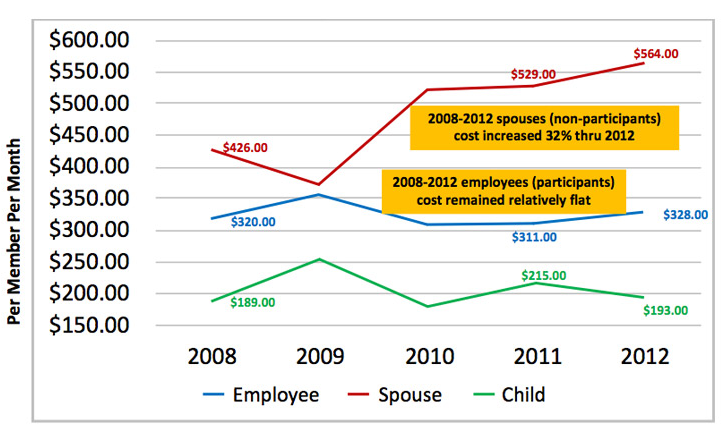It’s not just us–every grownup thinks there is too much prevention
When you read articles on prevention and corporate wellness, you tend to notice a pattern. Articles written by people who make their money pushing this stuff always say that the answer is more prevention. Those written by everyone else always say the answer is less prevention.
Here is an excellent example of the latter. It’s basically everything we’ve been saying, minus our trademark snarkiness.
Wellness promoter admits a 50% reduction in heart attacks needed to break even
Next to a being a Red Sox fan, I can’t imagine anything more depressing than being a member of the Wellness Ignorati. ALL the news about wellness is bad, and can’t be spun, which is just as well because the strategy of the Ignorati is not to “spin,” It’s to ignore facts rather than debate them. This prevents a news cycle, and reduces the odds that customers find out wellness doesn’t work.
Still, I am not sure how they would spin their way out of their latest debacle even if they tried.
CFO Magazine just posted a set of four essays in a debate. Mine summarizes the “con” arguments in 600 words. Since most of the first-string Ignorati refuse to debate, the editors found Mike Tinney and Mike Booth to pen the “pro” side. (No, we haven’t heard of them either.) Mr. Tinney urges CFOs to “take a leap of faith” on wellness ROI. Not sure that’s a compelling argument for an audience of CFOs, to put it mildly.
Indeed, one might conclude that, like the Red Sox, apparently the Ignorati don’t have much of a bench.
But wait…there’s more. Once again, the mantra: “In wellness, you don’t have to challenge the data to invalidate it. You merely have to read the data. It will invalidate itself” proves true. Mr. Tinney says to assume you have 1000 employees, and they will have about 2 heart attacks. Then he says: “If even one less [sic] person has a heart attack,” you save enough to pay for the program. What he failed to note is, in that hypothetical, a reduction of one heart attack would be a 50% reduction in heart attacks. No wellness promoter, even the most dishonest ones, say you can achieve remotely close to a 50% reduction in heart attacks. Hence, he is admitting you need an impossible reduction in events just to break even.
While reducing the number of heart attacks by one sounds feasible on its face, multiply the size of the population by 100. Now you have 100,000 people generating 200 heart attacks. Mr. Tinney says you need to avoid a Nobel Prize-worthy 100 of those heart attacks just to break even. By contrast, the HERO report achieved a zero reduction in their study.
So much for Mr. Tinney’s argument. But, hey, it beats Mike Booth’s defense of wellness. Incredibly, Mike Booth is still quoting the Harvard study. At this point every member of the Wellness Ignorati knows that study has been thoroughly debunked and basically retracted by its author (who says she has no interest in discussing wellness any more, and blames readers for misinterpreting her conclusion), so quoting this study without mentioning these tidbits is basically lying. It’s only slightly better than quoting the study linking autism to vaccines without mentioning it’s a fraud.
So that’s who’s promoting wellness now: yet another guy who can’t do math, and yet another guy who is either deliberately misleading people or lacks access to the internet.
More big news is that RAND finally came out of the closet altogether against wellness. No nuances, no “on the other hands”, no chance of being misinterpreted: Wellness is a loser.
Basically, every posting, every article, whether pro or con, leads an informed reader to the conclusion that wellness is a dumb idea. By contrast, even the Red Sox occasionally win a game.
The Graco-Goetzel-Bravo plot thickens…more twists and turns
The Graco-Goetzel-Bravo-Hopkins case study is turning into another Nebraska fiasco. As with Nebraska, the numbers all contradict one another. But unlike Nebraska, there has as yet been no admission of deliberate lying in the Graco case study. That’s why Graco only earned an honorable mention in the Koop Awards, instead of winning one outright like Nebraska did.
Consider Bravo’s case study on Graco covering the exact same population over the same period as Ron Goetzel’s study. Let’s assume Ron Goetzel is right in that the wellness program should be measured from 2009 rather than 2008, when the program started. (Bob Merberg’s brilliant analysis points out the cherrypicking of the date has a huge impact on claimed success, but let’s concede this start date choice to Ron, and use 2009 according to his wishes.)
Bravo’s case study displays the PMPM costs by year. The first thing to note is, they list employee healthcare costs at $328 PMPM, which actually makes sense, instead of the $190 PMPM in the Hopkins report. I don’t know why these two figures, purporting to cover the exact same population in the exact same period, are completely inconsistent, but I do know that $190 PMPM is an impossible figure, as any population health expert knows. (“Plausibility checking” would have caught that error but Ron has never taken our course in Critical Outcomes Report Analysis, which would have covered plausibility-testing and likely prevented him from making such a rookie mistake.)
Second, Bravo lists children’s healthcare costs in this report as well. Funny thing: over the same exact period in which Mr. Goetzel was claiming that the wellness program was responsible for controlling employee participant costs, children’s healthcare costs trended better than wellness participants’ costs. Mr. Goetzel obviously had access to this children’s cost trend data (we had no trouble finding it, thanks to Bob Merberg) but elected to — get ready to fall out of your seats — ignore it. The wellness ignorati rarely step out of character.
This children’s cost trendline appears to invalidate the entire Goetzel-Johns Hopkins conclusion that the healthcare cost trend was due to the wellness program, since not one single child participated in the wellness program.
For some reason Graco’s spouses cost about $7000 apiece a year. We’ll leave that for someone else to dissect.
As an aside, if anyone thinks they recognize the name “Bravo Wellness” from an earlier posting, it’s because they do. Bravo is the outfit that brags about their ability to save employers money by fining employees. Their website is disproportionately about their appeals process when those fines are levied. This sounds like a company that does wellness to employees instead of for them.
Not sure how bragging about fining employees is consistent with the positive culture that Mr. Goetzel says Graco has, but maybe I’m missing something here.
Eureka! We got criticized! An entire blogful of harsh words
 Please visit Michael Prager’s blog. Ironically, I don’t think we would take issue at all with his main point which appears to be that wellness should be done for employees instead of to them. (He is in the business of doing wellness for employees, not to them.) And, in fact, if he were actually thinking clearly about his own business success, he’d be pointing that out and trying to figure out ways to work together.
Please visit Michael Prager’s blog. Ironically, I don’t think we would take issue at all with his main point which appears to be that wellness should be done for employees instead of to them. (He is in the business of doing wellness for employees, not to them.) And, in fact, if he were actually thinking clearly about his own business success, he’d be pointing that out and trying to figure out ways to work together.
Second, note that our math and facts are never, ever criticized, even by our most virulent critics. What he criticizes is that we “mock critics who say that calling people ignorant is bullying.” Well, we call them the “ignorati,” not ignorant. “Ignorati” means they ignore facts, which is a brilliant strategy.
Third, he is breaking ranks with the ignorati, by not ignoring us. This creates a problem because he doesn’t actually point out a single thing we say that is wrong. Indecorous, perhaps, but wrong, no.
Michael, have at it: find a mistake in our math or a lie that we told about your integrity-challenged colleagues and we’ll apologize to it and link people to it. Go ahead, make our day. Because right now the fact that you, having shown that you are willing to criticize us, can’t find anything to actually criticize us about (other than our “bullying” observations that people who can’t do arithmetic shouldn’t be doing arithmetic), makes our case much better than we ever could.
Addendum: his is actually a very interesting blog on its own merits. He does do wellness for employees instead of to them ∞
Britney Spears Meets Ron Goetzel’s Institute for Health and Productivity Studies
 In the immortal words of the great philosopher Britney Spears, oops, they’re at it again.
In the immortal words of the great philosopher Britney Spears, oops, they’re at it again.
How this “study” gets published and why Johns Hopkins would allow its name to be used on it is anyone’s guess. In our last posting, we pointed out that in one place Graco’s employees cost $11,100 apiece to insure, just like other companies that offer competitive benefits. Yet later on in the story we see that employees only cost $2280. No mention of how these figures could be so inconsistent.
We let the rest of the study go, figuring we had already found the Macguffin. Ace reporter Bob Merberg, though, was not so easily convinced.
We’d urge reading his blog. Among the claims made by Mr. Goetzel was “revenues have doubled since 2009.” Well, yeah, but:
(1) it turns out Graco made a sizable acquisition in 2012, which might have had a teeny-weeny effect on revenues;
(2) revenues had plummeted in 2009, the year after the wellness program was introduced.
If you (a) measure from 2008, the year the wellness program was introduced, instead of cherrypicking the baseline year to give the best result, and (b) factor out the acquisition, revenues over the 2008-2014 period have pretty much tracked the economy as a whole. So nothing happened.
We can’t make this stuff up. Fortunately we don’t have to.




